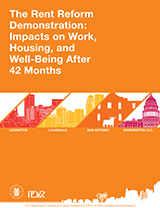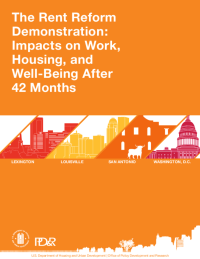The Rent Reform Demonstration: Impacts on Work, Housing, and Well-Being After 42 Months

 The purpose of the Rent Reform Demonstration is to test an alternative to the current rent policy for families using housing choice vouchers (HCVs). One goal of the alternative rent policy now being tested is to reduce what many believe are financial disincentives that discourage numerous voucher holders from working or increasing their earnings. Other goals are to reduce the complexity and burden (and, thus, the cost) of administering the rent policy, while not causing unnecessary hardship for HCV households. Using a rigorous random assignment design, the demonstration began enrolling voucher holders in 2015 in four cities at four Moving to Work public housing agency (PHA) sites with approximately 6,600 HCV-assisted households participating. The District of Columbia Housing Authority decided to end its participation in 2019, after the first stage of the project was completed, because of competing priorities the agency was facing at the time. The three remaining PHAs (Lexington Housing Authority, Louisville Metropolitan Housing Authority, and San Antonio Housing Authority) continued to operate the new rent policy for several additional years, providing an opportunity for longer-term follow-up research.
The purpose of the Rent Reform Demonstration is to test an alternative to the current rent policy for families using housing choice vouchers (HCVs). One goal of the alternative rent policy now being tested is to reduce what many believe are financial disincentives that discourage numerous voucher holders from working or increasing their earnings. Other goals are to reduce the complexity and burden (and, thus, the cost) of administering the rent policy, while not causing unnecessary hardship for HCV households. Using a rigorous random assignment design, the demonstration began enrolling voucher holders in 2015 in four cities at four Moving to Work public housing agency (PHA) sites with approximately 6,600 HCV-assisted households participating. The District of Columbia Housing Authority decided to end its participation in 2019, after the first stage of the project was completed, because of competing priorities the agency was facing at the time. The three remaining PHAs (Lexington Housing Authority, Louisville Metropolitan Housing Authority, and San Antonio Housing Authority) continued to operate the new rent policy for several additional years, providing an opportunity for longer-term follow-up research.
A central feature of the alternative rent policy is extending the time when a family has to recertify its eligibility for the voucher, and to have their share of the rent adjusted up or down according to changes in their income. While voucher holders are normally expected to recertify income increases at least annually, the alternative policy extended this to three years, substituting a “triennial recertification” for an “annual recertification.” Consequently, families’ portion of the rent would not be raised at all during those three years, no matter how much their income grew.
This report presents results through the first triennial recertification (covering more than three and a half years of follow-up) on the new rent policy’s impacts on labor market and housing-related outcomes based on administrative data and data from a long-term follow-up survey conducted approximately 42 months after the new rent policy took effect. The results indicate that, when the findings for all four PHAs are combined, the new policy did not increase tenants’ employment or average earnings in jobs covered by unemployment insurance during the 42-month follow-up. The story varied somewhat across locations, however, with some positive effects on earnings and employment, which were not consistent or sustained, in Lexington and San Antonio; no effects in Washington, DC; and the continuation of negative impacts seen previously in Louisville. The new rent policy’s hardship remedies were essential for protecting many families from an excessive rent burden. The alternative rent policy had little effect on overall material or financial well-being, causing no undue harm or improvement. Other findings for PHAs and families in the program group include (1) the new rent policy reduced the frequency and need for time-consuming actions related to regular and interim changes in families’ income through the triennial recertification and limited interim recertifications; and (2) the new rent rules led families to retain their housing assistance longer and, therefore, receive larger housing subsidies. In addition, a majority of tenants responding to the long-term follow-up survey in the new rent rules group favored the new rent policy (70.6 percent). A subsequent report, expected at the end of 2023, will examine the new rent policy’s effects over a six-year follow-up period; it will also provide a process evaluation of the second half of the demonstration.






